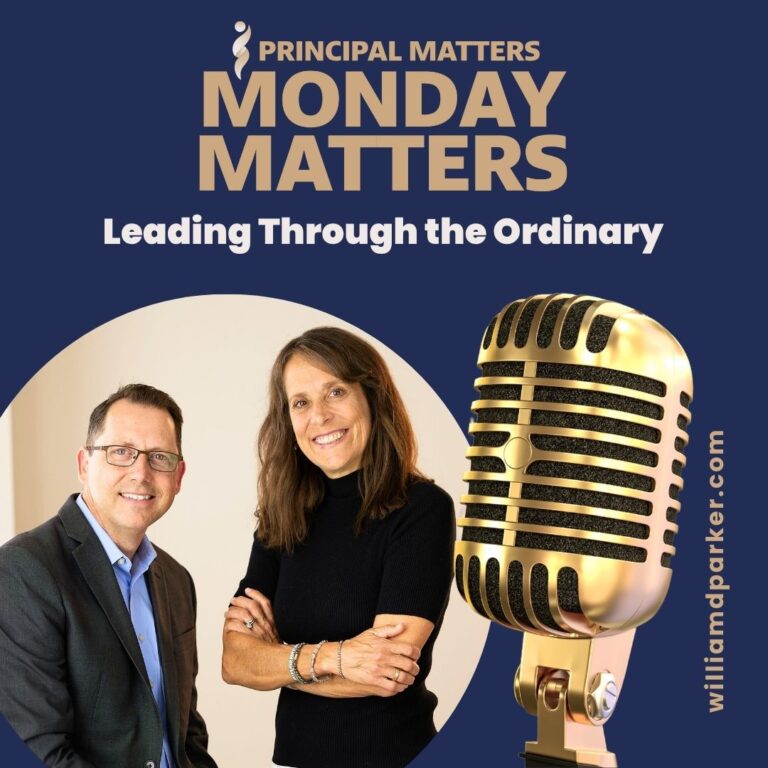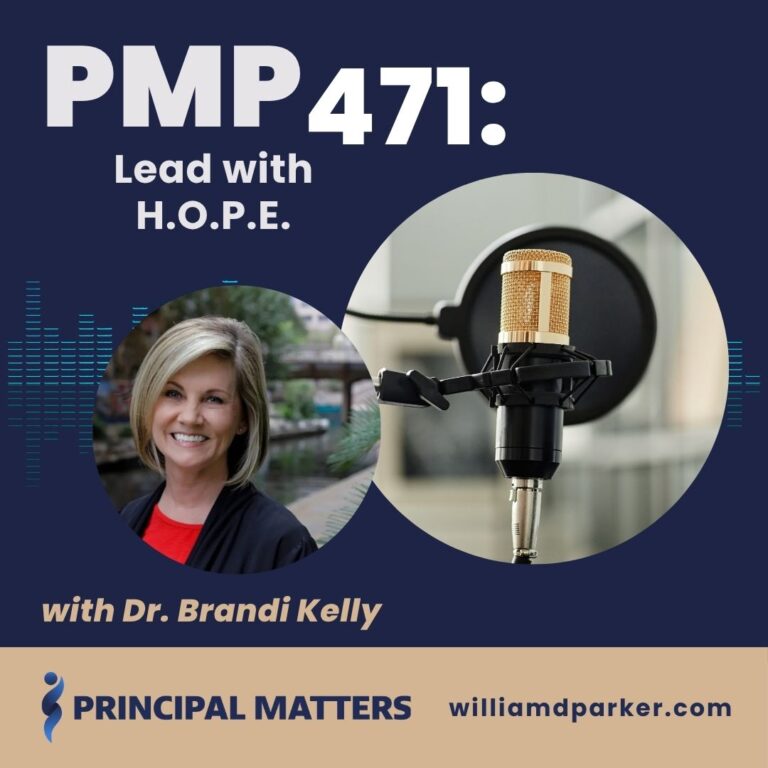Podcast: Play in new window | Download
Years ago, when I was transitioning from assistant principal to high school principal, my superintendent gave me an assignment to map out goals for the next three years of my school.

What was helpful about this assignment was the long-term planning required. Determining where I wanted my school to grow in the next three years meant taking a hard look at student data as well as understanding my school’s culture, community and resources.
In essence, my superintendent was asking me to think strategically. It is the strategic vision that helps us define the overall purpose and mission of our schools. But strategy is ineffective unless it is followed by action. I also needed organizational and tactical applications. Enter my staff, teachers, students and school community members. Leaders cannot implement strategic vision without the input and relationships of the people whom you are directly serving.
You may be asking: “How do I work tactically, operationally, and strategically during a time of pandemic?” “How do I respond to the pressures you are facing with current social and political unrest?“
Before I answer those questions, I want to first unpack the terms tactical, operational, and strategic in two separate applications.
#1 A Military Application
A few months ago, I interviewed Colonel Brad Ruttman, an Airforce officer and fighter pilot, on my podcast. Colonel Ruttman talked about tactical, operational and strategic leadership from a military perspective. In the military, tactical leadership involves the ‘boots on the ground’ activities and personnel – those who are involved in like maintaining equipment or the delivering of weapons, for instance. The operational side includes the day-to-day management and coordination of systems, protocols and policies that govern implementing the work at hand. Strategic leadership involves understanding the purpose of the overall mission and communicating what’s ultimately at stake as the entire organization is involved in successfully accomplishing its mission.
Colonel Ruttman told a story of when his commanding officer came to visit a division of maintenance operators at the end of their work day. He wanted to see them increase the speed of maintenance on aircraft so that pilots could accomplish more flights. He began to talk to them about strategic concerns happening with rival countries. Colonel Ruttman noticed the maintenance personnel members were only politely listening. Frankly, they didn’t care about the strategic mission at that point. They were at the end of a work day and wanted to head home and pick up their kids from football practice.
#2 A School Application
When you apply this to school leadership, your staff and teachers are often the ‘boots on the ground’ or tactical personnel in working with students in learning and well-being. Principals and building administrators often function as operational managers in organizational leadership, hiring personnel, overseeing site budgets, and guiding instructional outcomes. District leaders are tasked with strategic leadership: understanding the moving parts of the entire organization, including policies, school finance, oversight and compliance, and developing and relaying the mission of the collective community.
But for the people you serve, all they often care about is right in front of them. For parents, they want to know if their students are making good grades. For students, they want to know if they can still be a part of their favorite sport or activity. For teachers, they want to know what their key responsibilities are for instruction.
To meet the needs of your school members, however, school leaders must pay attention to the tactical, organizational and strategic – even if it is not what you are communicating to others on a day-to-day basis.
Unpacking the Standards
Several years ago, the National Policy Board for Educational Administration put together the Professional Standards for Educational Leaders, a document shared by almost all the national associations that support school leadership development. Just like we unpack standards for students, this report identifies ten standards for strong education leadership, including:
- Mission, Vision, and Core Values
- Ethics and Professional Norms
- Equity and Cultural Responsiveness
- Curriculum, Instruction, and Assessment
- Community of Care and Support for Students
- Professional Capacity of School Personnel
- Professional Community for Teachers and Staff
- Meaningful Engagement of Families and Community
- Operations and Management
- School Improvement
(Source here)
It’s easy to look at a list like this and see why education leaders, and principals in particular, have such wide-ranging responsibilities.
In any given day, you as the principal may be managing decisions involving placement and services for a student identified with severe and profound disabilities while minutes later observing and evaluating instruction for a teacher of Advanced Placement Calculus. You may be supervising students during a passing period followed by a meeting with a guiding coalition of student, teacher, and community leaders. You may be writing a weekly newsletter for your community and then attending an evening school board meeting.
The list goes on and on for how school leaders consistently manage the tactical, operational and strategic responsibilities under their care.
Managing During a Pandemic
And then throw in managing during a pandemic. Suddenly, you are asked to re-structure an entire school master schedules for in-person, virtual or hybrid offerings. Your district may be in a highly populated area where in-person instruction is impeded by high infection rates. Or perhaps you’re in a rural setting where your school began in-person but now you have so many adults testing positive, you no longer have substitutes available to service students so you have pivoted to virtual instruction for the first time.
Throughout this school year, the strategic tasks involved in education leadership have often been eclipsed by the tactical and organizational requirements of meeting the basic needs of student well-being and instruction.
So how do you keep leading in this new reality?
First, acknowledge that you can only control what you can control. Second, you are managing change. And change is stressful and always results in some kind of resistance.
Wired to Resist Takeaways
In 2017, Britt Andreatta wrote a book called Wired to Resist: The Brain Science of Why Change Fails and a New Model for Driving Success. Andreatta’s studies show that our biological reactions to change are evident in the different cortexes of the human brain.
Three things happen to your brain when confronted by change:
1. Fear Response
The Amygdala is the part of our brain that reacts to change with flight or flight reaction. Even in organizational change, our amygdala kicks into gear when we are asked to do something new, innovative, or disruptive. Educators know that disequilibrium is a powerful force in creating learning opportunities.
People cannot operate or think clearly when they feel deeply threatened by change. That is why leaders have to guide, direct, coach, and anticipate change with as much patience as they can muster. When we do, we help relieve some of the stress that naturally takes place when the amygdala floods the brain with danger alerts.
2. Personal GPS
The Entorhinal Cortex of the brain helps us navigate new settings, situations or changes. Sometimes people react to new environments with curiosity while others may react with panic. It is important to understand that when someone is either optimistic or resistant, they still have an uphill climb mentally when they are facing any new change. Think about the first time you worked in a new school or classroom. Until you figured out a place for everything and had organized that new environment for habitual use, you burned a lot of brain energy adjusting.
The same stress happens with any other changes: email upgrades, website changes for absence requests, curriculum mapping programs…pandemics. Any time we introduce anything new into the daily tasks of our team members or students, expect resistance as the entorhinal cortex kicks in the navigate the changes, memorize patterns, and establish new habits.
This is why many leaders I talk to have spent most of the year trying to establish new norms. Whether they are in-person or serving students virtually, they are working harder to establish routines that reduce the stress that happens with constant change.
3. Embedded Routines
The Basal Ganglia is the third part of the brain cortex Andreatta describes in her book. This is the part of the brain that helps us move from identifying new patterns to memorizing them and storing them into our brain as newly learned habits. The longer we practice an action, the more engrained it becomes in our muscle memory. And this happens because the basal ganglia transfers information into stored memory that if practiced long enough can eventually become almost second nature.
Here’s a quick application: Understanding how the human brain reacts to change helps us realize that resistance to change is normal. Under the best circumstances, you try to look down the road and plan for change in advance. In times like we are in now, you are often managing change on the run. Tactical, organizational and strategic leadership are still important. But keep in mind that change always result in times of resistance.
5 Practical Applications of Leading Through Change
As I’ve talked to principals across my state and across the nation, here are some things I’m learning that may be helpful for you to keep in mind as you try to manage the tactical, operational and strategic roles in leading during times of change:
- Work the plan. Many schools with strong organizational plans for both in-person and/or at-home instruction have still been able to serve students. I know there is a lot of pressure for school leaders and teachers to feel like they must be back to school as normal and serving at high levels of performance. The truth is no one is doing it perfectly. Some are experiencing more success than others. For those I’m seeing be more successful, it is often because they developed plans far in advance that they are still executing with as much consistency as possible.
- Remember when a new process becomes routine, it becomes more manageable. I’ve talked to many leaders who are beginning to find some stride in their new school protocols. At the same time, a surge in community infections can change that overnight. Don’t beat yourself up if you are managing conditions beyond your control. The safety and well-being of your students and staff must still come first as you respond to circumstances within and outside of your control.
- You still serve as a powerful influence on maintaining patience and calm during uncertainty. A leader’s measured response during difficult times sets the tone for others. You won’t do this perfectly, but keep in mind that your brain and every brain in your building is trying to adjust to change. It’s okay to admit it’s stressful. Keep treating others like you would want to be treated when you are asked to change.
- Find ways to celebrate success while maintaining a sense of optimism during times of uncertainty. I’m still hearing wonderful stories from principals who take time to recognize student and teacher success. This past week Kim Coody, Glenpool High School, near Tulsa, Oklahoma had one of her teachers highlighted on the nightly news for the ways he has been interviewing students and helping them serve families during the pandemic. Even though your communication with parents is more often about schedules or plans, still take time to give kudos to the others.
- Keep tabs on your staff and teachers. Another principal, Samantha Bartrom, from Coastal Academy in Escondido, California, told me recently, she has made it a point to reach out to each of her teachers for one-on-one feedback. When she does this, it allows teachers to voice in private what they may not want to voice in a larger group setting. Keep building trust in your staff so that they you care and want to listen.
Let’s Wrap This Up
At the end of Andreatta’s book, she gives advice for how to take personal, proactive steps during times of change. The three strategies I liked most:
• Self-care
• Mindfulness
• Play
Just like you may increase good nutrition, sleep, and vitamin intake to increase your chances to stay healthy during past flu seasons, taking care of yourself through healthy practices allows you to better manage the stresses that happen to your brains, bodies, and emotions during times of change.
Now It’s Your Turn
In the days and months ahead, school leaders still have a far way to go before pandemic conditions improve and vaccinations begin making a significant difference. Thank you for the ways you’ve lead with courage and sacrifice. Whether you are managing tactically, operationally or strategically, you are doing so during times of enormous change. Leading in uncertainty is hard. That’s why we need leaders like you.
How can you plan ahead while also giving yourself permission that it is normal to be stressed during times of change? How can you practice patience in the ways you interact with anxious students, staff, and community members? What’s one action you can take today to keep caring for yourself so that you can keep caring for others during times of uncertainty? Thanks again for doing what matters!




